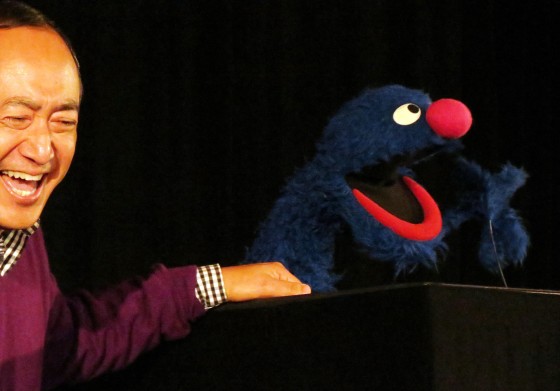Alan and Grover promote reading program. Photo by Caroline McDonald
A program to promote daily reading for young children was announced today at the New York Public Library in Manhattan. Making an appearance to bring attention to the Every Day is a Reading and Writing Day program were the popular Elmo, Grover and Alan Sesame Street characters.
“Studies have shown that less than half of children between birth and five years old are read to every day by parents or caregivers,” William E. Ross, chief executive officer of the Insurance Industry Charitable Foundation said at the event. “So it’s not surprising that out of 50 children, 44 have reading problems when they enter the third grade.”
Even before starting school, children from high-income families have the advantage of 400 hours more of literacy-related activities than those from low-income families, according to the Sesame Workshop. By age four, a child from a high-income home is exposed to 35 million more words than a low-income child.
Ross noted that reading and writing skills set children up for success and that “The goal is for children to arrive at their classes with stronger skills.”
To help narrow the gap, the IICF and Sesame Workshop, the nonprofit, educational program behind Sesame Street, have partnered to form an online bilingual—English and Spanish—digital resource center. The resource includes games and activities to encourage parents, families and caregivers to interact with young children and improve their reading and writing skills.
Sesame Street is promoting the program nationwide, also making appearances in Chicago, Dallas and Los Angeles.
“We have a civic responsibility to support the development of youth,” Ross said, adding that the insurance industry is caring and philanthropic and has the available resources to focus on national issues.
The IICF, established in 1994, is directed and funded by the insurance industry. The organization said it has contributed more than $20 million in grants to charities and 166,000 volunteer hours to hundreds of nonprofit community programs.
Goals of Every Day is a Reading and Writing Day are to:
• Help parents and caregivers realize the importance of their role in creating the foundation for literacy in their children.
• Give volunteers engaging, fun-filled and educational resources to positively impact the literacy development of undeserved children across the United States.
• Provide children with games and activities to stimulate their interest in talking, reading, and writing from an early age.

